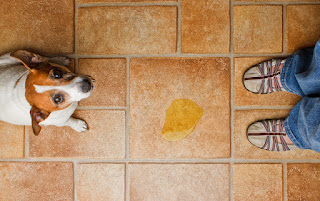Box Braid Tug Toy
You will need:
4, 4”x48” Fleece Fabric Strips (You can easily customize the toy by using different colored fleece or even strips of an old T-shirt!)
Scissors
Ruler
1. Use the ruler and scissors to cut your strips of fabric into 4”x48” pieces.
2. Tie the four pieces together in a knot at one end.
3. Lay the fabric down on the table, so the fabric falls in four different directions and looks like a lowercase letter t.
4. Fold the first vertical strand to the opposite side, creating a loop. Fold the opposing vertical strand to the opposite side, creating another loop.
6. Pull the four strands tightly. (Pulling the top left hand side strand and the bottom right hand stand extremely tight simultaneously, and vice versa, will help you keep your box uniform.)
Continue steps 4 through 6 until you only have about a foot of fleece left, then knot the end of the toy. Now your tug toy is ready for use!
Bottle Kibble Toy
Old Bottle
Scissors or Exacto Knife
Small KibbleScissors or Exacto Knife
1. Remove the cap of the bottle and throw it away.
2. Cut small holes in the bottle at different areas. (You can vary the size of the holes and the amount of holes in order to change the level of difficulty for your pooch. Smaller and more infrequent holes will make it harder for your dog to remove the kibble.)
3. Add treats to the toy, and give it to your pooch for them to enjoy.
Make sure that you supervise your dog when you give them their new kibble toy. It’s easy for a destructive chewer to get through a bottle quickly. In order to make the toy last longer, you can use sturdier bottles. Although water bottles will work fine, a thicker plastic will be harder for your pup to chew through.
For a quick, easy and inexpensive way to keep your pooch entertained at home, making homemade toys is a stress-free way to go. Looking for more ideas? Take a look around your house; the closet, the garage sale box, even the recycling bin! You’d be surprised how many potential homemade toys are already at your fingertips.












